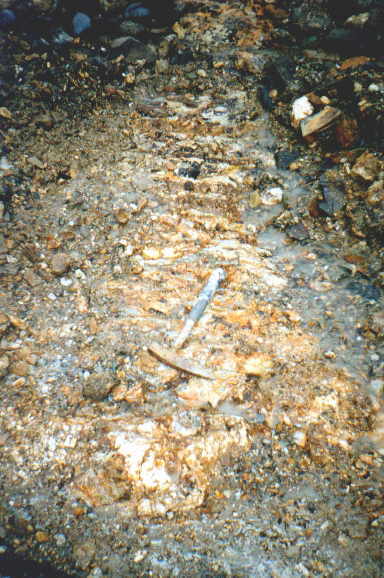Lode on:
[Wikipedia]
[Google]
[Amazon]
 In
In
 In
In geology
Geology () is a branch of natural science concerned with Earth and other Astronomical object, astronomical objects, the features or rock (geology), rocks of which it is composed, and the processes by which they change over time. Modern geology ...
, a lode is a deposit of metalliferous ore that fills or is embedded in a fissure
A fissure is a long, narrow crack opening along the surface of Earth. The term is derived from the Latin word , which means 'cleft' or 'crack'. Fissures emerge in Earth's crust, on ice sheets and glaciers, and on volcanoes.
Ground fissure ...
(or crack) in a rock formation or a vein
Veins are blood vessels in humans and most other animals that carry blood towards the heart. Most veins carry deoxygenated blood from the tissues back to the heart; exceptions are the pulmonary and umbilical veins, both of which carry oxygenated ...
of ore that is deposited or embedded between layers of rock.
The current meaning (ore vein) dates from the 17th century, being an expansion of an earlier sense of a "channel, watercourse" in late Middle English, which in turn is from the 11th-century meaning of ''lode'' as a ‘course, way’.
The generally accepted hydrothermal model of lode deposition posits that metals dissolved in hydrothermal solutions (hot spring fluids) deposit the gold or other metallic minerals inside the fissures in the pre-existing rocks. Lode deposits are distinguished primarily from placer deposit
In geology, a placer deposit or placer is an accumulation of valuable minerals formed by gravity separation from a specific source rock during sedimentary processes. The name is from the Spanish word ''placer'', meaning "alluvial sand". Placer mi ...
s, where the ore has been eroded out from its original depositional environment
In geology, depositional environment or sedimentary environment describes the combination of physical, chemical, and biological processes associated with the deposition of a particular type of sediment and, therefore, the rock types that will be ...
and redeposited by sedimentation
Sedimentation is the deposition of sediments. It takes place when particles in suspension settle out of the fluid in which they are entrained and come to rest against a barrier. This is due to their motion through the fluid in response to the ...
. A third process for ore deposition is as an evaporite
An evaporite () is a water- soluble sedimentary mineral deposit that results from concentration and crystallization by evaporation from an aqueous solution. There are two types of evaporite deposits: marine, which can also be described as ocean ...
.
A stringer lode is one in which the rock is so permeated by small veinlets that rather than mining the veins, the entire mass of ore and the enveined country rock
Country rock is a genre of music which fuses rock and country. It was developed by rock musicians who began to record country-flavored records in the late 1960s and early 1970s. These musicians recorded rock records using country themes, vocal ...
is mined. It is so named because of the irregular branching of the veins into many anastomosis
An anastomosis (, plural anastomoses) is a connection or opening between two things (especially cavities or passages) that are normally diverging or branching, such as between blood vessels, leaf veins, or streams. Such a connection may be norm ...
stringers, so that the ore is not separable from the country rock.
One of largest silver lodes was the Comstock Lode in Nevada, although it is overshadowed by the more recently discovered Cannington Lode in Queensland, Australia. The largest gold lode in the United States was the Homestake Lode. The Broken Hill Lode in South Australia is the largest lead-zinc lode ever discovered.
See also
*Lodestone
Lodestones are naturally magnetized pieces of the mineral magnetite. They are naturally occurring magnets, which can attract iron. The property of magnetism was first discovered in antiquity through lodestones. Pieces of lodestone, suspen ...
known just as ''lode'' in the 16th and 17th centuries.The ''New Oxford American Dictionary
The ''New Oxford American Dictionary'' (''NOAD'') is a single-volume dictionary of American English compiled by American editors at the Oxford University Press.
''NOAD'' is based upon the ''New Oxford Dictionary of English'' (''NODE''), published ...
'' (''NOAD''), 3rd edition.
* Mother lode, the principal vein
* Ore genesis
* Thickness
*General Mining Act of 1872
The General Mining Act of 1872 is a United States federal law that authorizes and governs prospecting and mining for economic minerals, such as gold, platinum, and silver, on federal public lands. This law, approved on May 10, 1872, codified the ...
*Land patent
A land patent is a form of letters patent assigning official ownership of a particular tract of land that has gone through various legally-prescribed processes like surveying and documentation, followed by the letter's signing, sealing, and publi ...
* Binger Hermann
*Surveying
Surveying or land surveying is the technique, profession, art, and science of determining the terrestrial two-dimensional or three-dimensional positions of points and the distances and angles between them. A land surveying professional is ...
*Geographic information system
A geographic information system (GIS) is a type of database containing geographic data (that is, descriptions of phenomena for which location is relevant), combined with software tools for managing, analyzing, and visualizing those data. In a ...
Notes
Ore deposits Mineralogy Economic geology {{Geology-stub